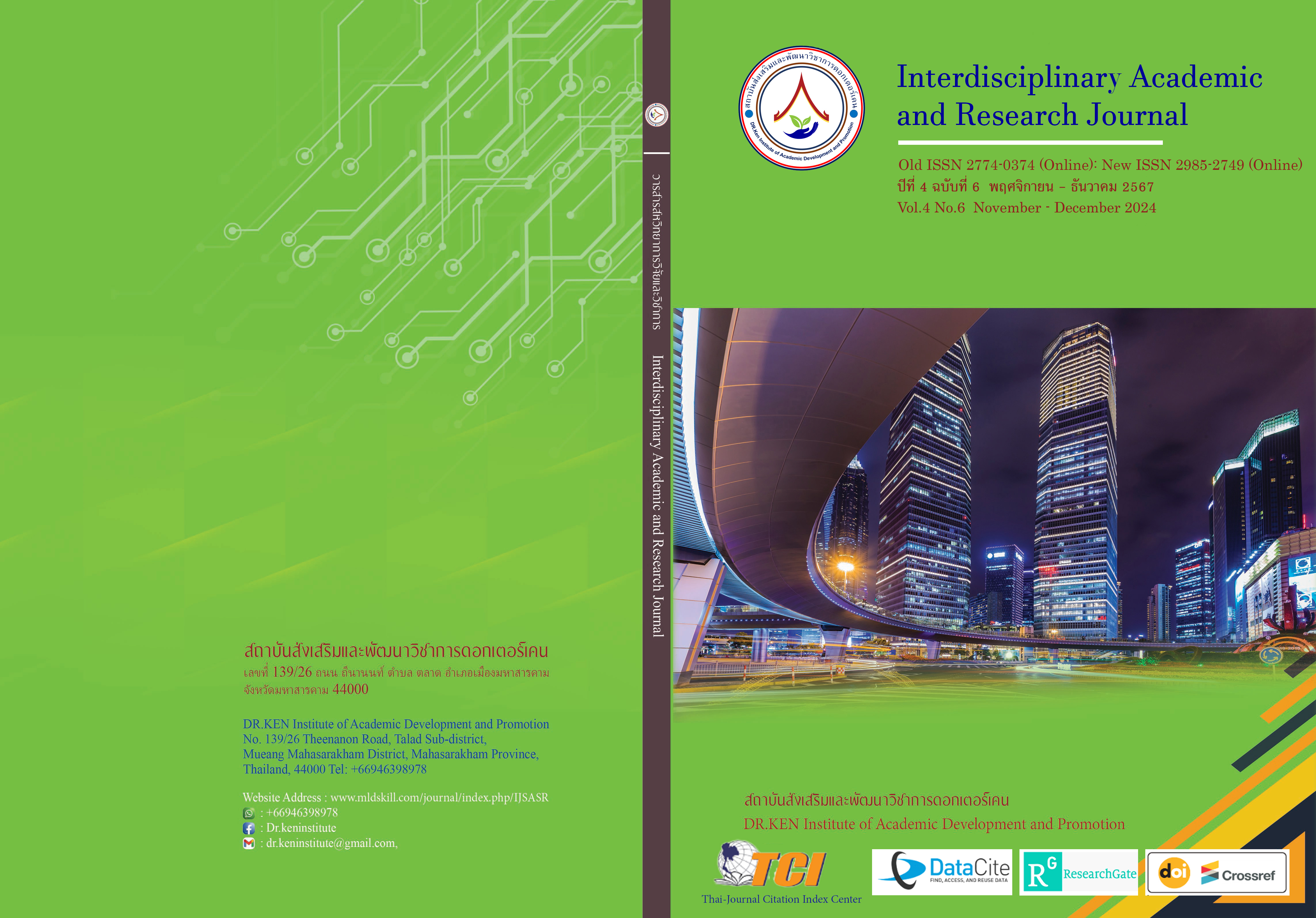Learning Model of Intelligent Sign Language Online
DOI:
https://doi.org/10.60027/iarj.2024.276973Keywords:
Sign Language Learning, Sign Language, Online Learning, Smart Online LearningAbstract
Background and Aims: Learning smart sign language online is particularly interesting nowadays due to various technologies and platforms that facilitate learning and communication in this domain. Therefore, research on intelligent online learning formats for sign language is of great interest across multiple dimensions. This research aims to: 1) Develop intelligent online learning formats for sign language; 2) Evaluate these intelligent online learning formats.
Methodology: The study includes two groups: 9 experts involved in analyzing and designing intelligent sign language learning formats, and 9 qualified evaluators using purposive sampling. Research tools consist of structured deep interviews and format evaluation questionnaires. Statistical methods include basic statistics such as mean and standard deviation, and quality statistics of research tools like question validity and confidence intervals.
Results: The findings reveal: (1) Intelligent online sign language learning formats consist of six components: principles of 21st-century learning, teaching sign language learning skills, intelligent sign language learning environments, knowledge round-based sign language learning activities, and learning format assessment. And (2) Evaluation results from qualified evaluators show overall high levels of feasibility, accuracy, appropriateness in learning format management, and usefulness in learning management formats.
Conclusion: The results demonstrate that six essential components of intelligent online sign language learning formats are in line with 21st-century educational ideas. According to evaluations, these formats are very accurate, suitable, workable, and practical for efficient learning management.
References
เกษมศรี ภัทรภูริสกุล. (2544). การศึกษาผลสัมฤทรธิ์ทางการเรียน ความคงทนในการเรียน และความสนใจในการเรียนวิขาคณิตศาสตร์ ของนักเรียนชั้นประถมศึกษาปีที่ 6 ที่ได้รับการสอนด้วยทฤษฎีสรรคนิยม. ปริญญานิพนธ์ กศ.ม. (การมัธยมศึกษา). กรุงเทพฯ: บัณฑิตวิทยาลัย มหาวิทยาลัยศรีนครินทรวิโรฒ.
บุญชม ศรีสะอาด. (2556). การวิจัยเบื้องต้น. พิมพ์ครั้งที่9. กรุงเทพฯ : สุวีริยาสาส์น.
ประกอบ กรณีกิจ. (2550) การพัฒนารูปแบบแฟ้มสะสมงานอิเล็กทรอนิกส์โดยใช้การประเมินตนเอง เพื่อส่งเสริมการคิดอย่างมีวิจารณญาณของนิสิตนักศึกษาฝึกประสบการณ์วิชาชีพครู . จุฬาลงกรณ์มหาวิทยาลัย.
มาลี จุฑา. (2544). การประยกตจิตวิทยาเพื่อการเรียนรู้. กรุงเทพฯ : อกษราพิพัฒน์.
วิจารณ์ พานิช. (2555). วิถีสร้างการเรียนรู้เพื่อศิษย์ในศตวรรษที่ 21. สำนักพิมพ์มูลนิธิสดศรีสฤษดิ์วงศ์.
วิชัย วงษ์ใหญ่ และ มารุต พัฒผล. (2564). การเรียนรู้ปรับได้ Adaptive Learning. กรุงเทพฯ : ศูนย์ผู้นำนวัตกรรมหลักสูตรและการเรียนรู้ มหาวิทยาลัยศรีนครินทรวิโรฒ.
วีระยุทธ สุภารส. (2556). การพัฒนาบทเรียนอิเล็กทรอนิกส์กระบวนวิชาภาษามือเบื้องต้น สำหรับนักศึกษา. ระดับปริญญาตรี. วิทยานิพนธ์ปริญญามหาบัณฑิต, มหาวิทยาลัยเชียงใหม่.
อารี รังสินันท์. (2527). ความคิดสร้างสรรค์. กรุงเทพฯ : ธนกิจการพิมพ์.
Akhmedova, A.R., Koda, E.A., Dylkina, T.V., & Fomenko, A.P. (2022). Social Employment Practices of People with Hearing Impairment (Based on the Materials of a Sociological Study in Barnaul). Sociodynamics, 10, 31-45. https://doi.org/10.25136/2409-7144.2022.10.39118
Anderson, T. (Ed.). (2008). The theory and practice of online learning. Athabasca university press.
Bates, A.W. (2015). Teaching in a digital age: Guidelines for designing teaching and learning. BCcampus.
Bhatt, G.D. (2001). Knowledge management in organizations: examining the interaction Between technologies, techniques, and people. Journal of Knowledge Management, 5 (1), 68-75.
Black, P., & Wiliam, D. (1998). Assessment and classroom learning. Assessment in Education: principles, policy & practice, 5(1), 7-74.
Bruner, J.S. (1963). The process of education. New York : Vintage Books.
Carolina, T.B., Aharonson-Daniel, L., & Feder-Bubis, P. (2023). Resources Used by People with Hearing Disabilities to Cope with Emergency Situations. Prehospital and Disaster Medicine. 38. s113-s113. Doi: 10.1017/S1049023X23003059.
Emmorey, K. (2023). Ten Things You Should Know About Sign Languages. Current Directions in Psychological Science, 32(5), 387-394. https://doi.org/10.1177/09637214231173071.
Intarapoo, A., & Wannapiroon, P. (2023). Intelligent Digital Learning Environment for Enhancing Teaching Professional Experience. Technical Education Journal KMUTNB. 12 (1), 193-204.
Koehler, M.J., & Mishra, P. (2009). What Is Technological Pedagogical Content Knowledge? Contemporary Issues in Technology and Teacher Education, 9, 60-70.
Levasseur, M. (2023). Influence of Hearing Loss on Social Participation in Older Adults: Results from a Scoping Review. Research on Aging, doi: 10.1177/01640275231174561
Lientjie Janse Van Rensburg-Welling, Mitchell, J., & Goosen, W. (2022). Sensitizing Prospective Workplaces on the Needs of Students with Hearing Impairments. Global Journal of Social Sciences Studies, Online Science Publishing, 8(2), 35-47. DOI: 10.55284/gjss.v8i2.714
Luckin, R., Holmes, W., Griffiths, M., & Forcier, L. B. (2016). Intelligence Unleashed: An Argument for AI in Education. Pearson. https://static.googleusercontent.com/media/edu.google.com/en//pdfs/Intelligence-Unleashed-Publication.pdf
Mandala System. (2023). Artificial intelligence (AI). Retrieved April 22, 2024, from: https://www.mandalasystem.com/blog/th/297/What-is-artificial-intelligence-AIBabita
Mayer, R. E. (2019). Computer games in education. Annual Review of Psychology, 70, 531–549. https://doi.org/10.1146/annurev-psych-010418-102744
Moore, M. and Kearsley, G. (2012) Distance Education: A Systems View of Online Learning. 3rd Edition, Wadsworth, Belmont.
Papatsimouli, M., Sarigiannidis, P., & Fragulis, G. (2023). A Survey of Advancements in Real-Time Sign Language Translators: Integration with IoT Technology. Technologies. 11 (4), 83. Doi: 10.3390/technologies11040083.
Payauncharoen, P. (2021). SiGn language เรียนรู้ผ่านภาษามือ. insKru. Retrieved from: https://inskru.com/idea/-MraJozQ2yOmXUxt6bL8
Quinto-Pozos, D., Singleton, J., Hauser, P., Levine, S., Garberoglio, C., & Hou, L. (2013). Atypical signed language development: A case study of challenges with visual-spatial processing. Cognitive neuropsychology. 30, 332-359. 10.1080/02643294.2013.863756.
Stewart, D.A., & Kluwin, T. N. (2001). Teaching deaf and hard of hearing students: Content, strategies, and curriculum. Allyn and Bacon.
Trilling, B., & Fadel, C. (2012). 21st-century skills: Learning for life in our times. John Wiley & Sons.
Vygotsky, L.S., & Cole, M. (1978). Mind in society: Development of higher psychological processes. Harvard University Press.
Downloads
Published
How to Cite
Issue
Section
License
Copyright (c) 2024 Interdisciplinary Academic and Research Journal

This work is licensed under a Creative Commons Attribution-NonCommercial-NoDerivatives 4.0 International License.
Copyright on any article in the Interdisciplinary Academic and Research Journal is retained by the author(s) under the under the Creative Commons Attribution-NonCommercial-NoDerivatives 4.0 International License. Permission to use text, content, images, etc. of publication. Any user to read, download, copy, distribute, print, search, or link to the full texts of articles, crawl them for indexing, pass them as data to software, or use them for any other lawful purpose. But do not use it for commercial use or with the intent to benefit any business.
















.png)


